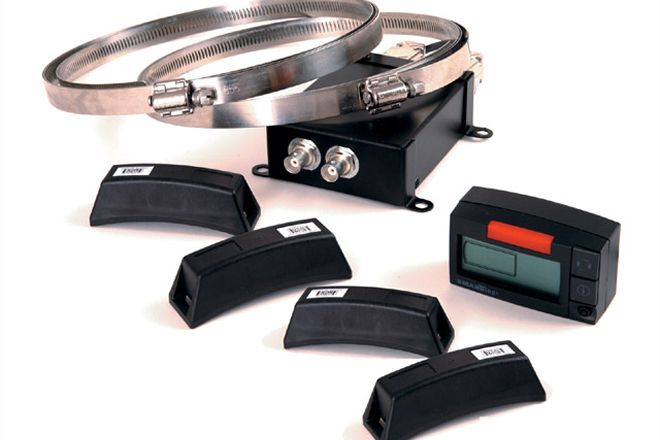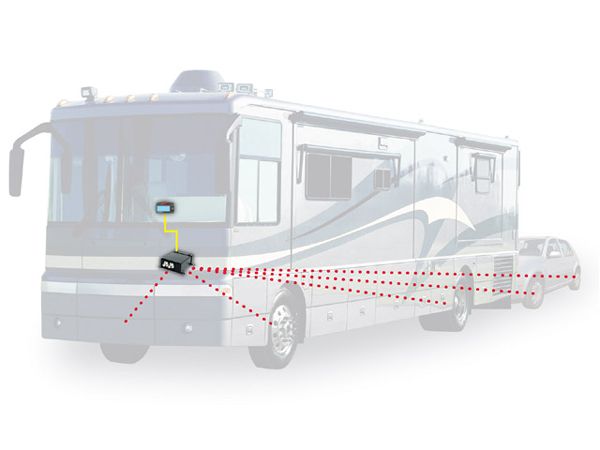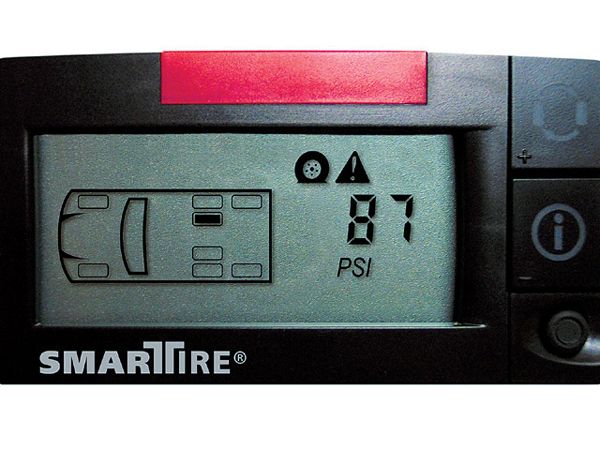
 The basic SmarTire kit comes with four transmitters, stainless steel straps, a receiver, and a backlit dash-mounted display.
The basic SmarTire kit comes with four transmitters, stainless steel straps, a receiver, and a backlit dash-mounted display.
We all know about the importance of checking and maintaining proper tire pressure. I can count the number of tire failures we've had on one hand. A tire failure is different than a simple puncture that you fix in camp or at the nearest tire center. Tire failures invariably come from having a low tire or a puncture, and not catching it before the tire overheats. Ninety percent of all tire failures are a result of tire underinflation. Twenty percent underinflation reduces carcass life by 30 percent, reduces tread life by 25 percent, and reduces fuel mileage by 2 percent.
When you have a flat, first you feel that squirminess, and then you stop. When you open the door and smell hot rubber, it's too late. The tire's sidewall has overheated, and delamination is probable. If you're lucky, you felt that "squirminess" early on and were able to stop in time.
 When used on an RV or other tow vehicle, the SmarTire Gen II can monitor as many as 20 tires, on six axles.
When used on an RV or other tow vehicle, the SmarTire Gen II can monitor as many as 20 tires, on six axles.
But what about the trailer you're pulling? Yeah, that $60,000 fifth-wheel toy hauler with three slide-outs, or the flatbed with your prized rockcrawler. If you knew that the right rear tire on the tandem-axle trailer was 15 pounds low, dangerously hot, and probably about to blow-think you'd stop? Good idea, because it's very unlikely that you are going to feel that "squirminess" before it's too late.
SmarTire has come to the rescue again with its recently introduced Generation II RV Tire Monitoring System. The new SmarTire System can keep an electronic wireless eye on as many as 20 tires, on six axles, and up to 177 psi.
How does it work? A small wireless sensor is securely mounted inside each tire on the rim. As the tire spins, the sensor begins sending data to a remote receiver in the cab every 12 seconds. The receiver then processes the data transmissions and compares them to preprogrammed settings to determine if a tire is underinflated. At the push of a button, real-time tire pressure is then available to the driver via a dash-mounted display. If the system detects a tire that is operating underinflated, the system automatically warns you of the condition with a flashing light and a beeper before it becomes dangerous-giving you ample time to pull off the road before you destroy an expensive tire, or worse, cause an accident.
Depending on the length of your rig, small auxiliary antennas plug into the receiver to assure good reception. A lithium battery rated for 10 years or 100,000 miles powers the sensors. Tires can be rotated and the sensors reprogrammed. They can also be moved to your next set of rubber. The receiver can be hard-wired to ignition 12-volt, or plugged into your cigarette lighter.
In addition to pressure, the SmarTire monitor tells you the preset required pressure of each axle, overall pressure status, and the temperature inside each tire. This last feature is particularly valuable to us, because we frequently air down our tires for off-highway use, like washboard or gravel roads to allow the tire to absorb the bumps and sharp rocks. We lower the pressure even more in sand or serious four-wheel-drive conditions. As the road improves and our speed increases, in the past we have had no way of knowing if the lower pressure in the tires was causing an unsafe rise in temperature. Now we can monitor the temperature and decide whether to slow down or stop and air up.
No matter how hot it is outside or how hot a tire gets rolling down the road, SmarTire RV's temperature compensation will always provide accurate tire inflation information. After all, temperature is a tire's biggest enemy. As a tire deflates, its rolling resistance increases and its operating temperature goes up. As its temperature increases, the air inside the tire expands, so the tire appears to be operating at correct inflation. When measured using a non-temperature-compensated gauge, a tire can be 30-percent under-inflated and still appear to be normal. SmarTire measures a tire's temperature in addition to pressure in order to do a temperature-compensation calculation. The system provides deviation numbers in its on-demand tire information and a first-level alert showing exactly how many psi under- or over-inflated a tire is at its operating temperature.
 The little dash-mounted display screen has the capability of a small computer. You can scroll through all tires in the system for both pressure and temperature.
The little dash-mounted display screen has the capability of a small computer. You can scroll through all tires in the system for both pressure and temperature.
Many people drive out of the dealer's garage and don't check their tire pressure again until the next scheduled service, months later. Worse still, they arrive at their RV storage lot, hook up, and head down the road, oblivious that their trailer's tires are dangerously low. This may come as a shock to many people, but tires leak. Tires, whatever high-tech compounds they may be made of (otherwise called rubber), are basically a semi-permeable membrane. If the concentration of air molecules is greater on the inside than the outside, they will try to equalize. (Read: leak.) Of course, if they have the help from a nail, thorn, or sharp rock, they'll do it much faster. According to one tire-company engineer we spoke to, "Under ideal conditions, they have about as good a chance of holding air as a penny balloon."
Even a visually unnoticeable 5 pounds of pressure, low or high, can cause premature tire wear, poor handling, or an uncomfortable ride. The printed "recommended tire pressure" on the tire's sidewall is a guideline for average conditions. If you're running around in an F-350 dualie, empty, with fully inflated tires, you're probably beating yourself to death. Conversely, under-inflated tires cause increased fuel consumption, which in turn releases more harmful emissions into the atmosphere, both important considerations. By adjusting tire pressure to the load and road conditions, and monitoring the temperature, you can significantly improve your ride without going below safe tire pressures. A slightly lower pressure on your trailer tires might help keep cabinet doors closed and glasses upright.
The SmarTire System can be installed on virtually any tire-and-wheel combination. Since most of our vehicles only have four tires on the road, installing the SmarTire System is pretty simple. Setting it up for a dualie (six tires), or a big fifth-wheel with three axles and six more tires, is a bit more complicated. The little dash-mounted display screen has the capability of a small computer. The complexities of setting up a truck and trailer system for optimal performance can be daunting for computer illiterates like us. We discovered an easy answer to this problem.
Bob Dickman's Les Schwab Tire Center in Junction City, Oregon, has become one of the country's largest distributors of the SmarTire Systems. By supplying them with the details of your truck and trailer combination, or just your four wheeler, they will preprogram the SmarTire Gen II specifically for your use-turnkey-and if necessary explain to your local tire dealer the procedure for installing the transmitters and receiver. An automotive electrical or stereo shop can also install the receiver.







